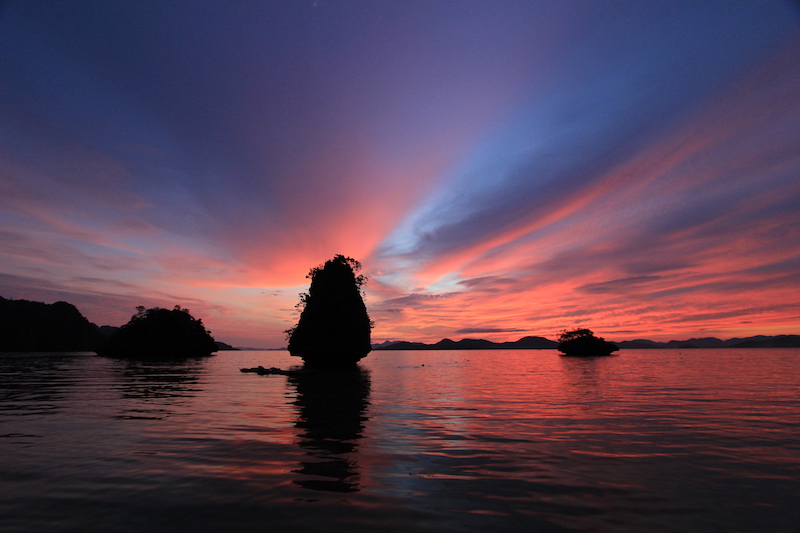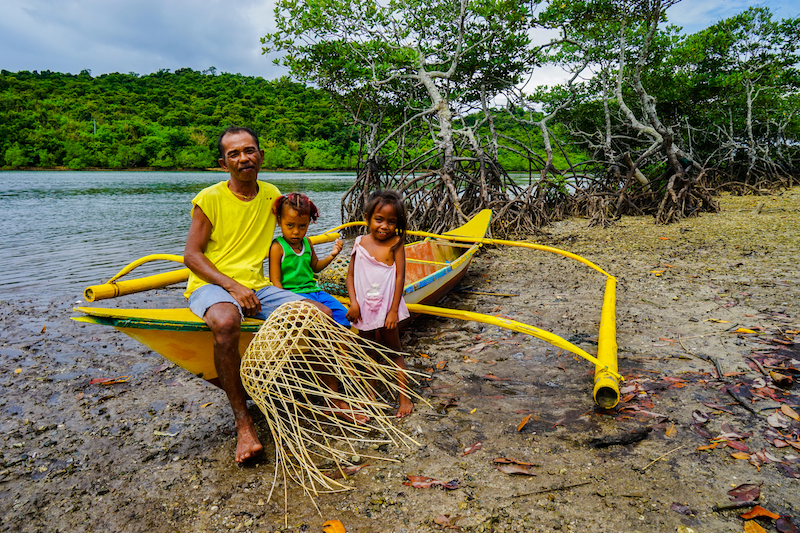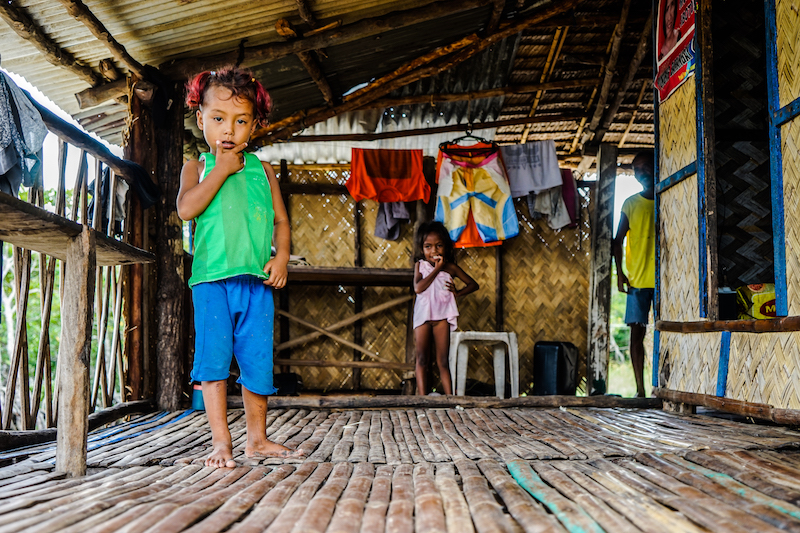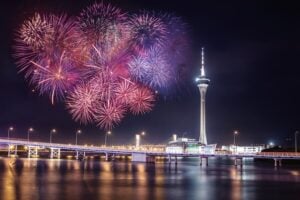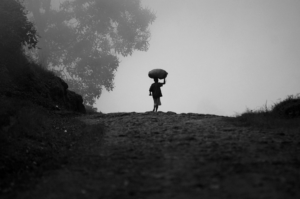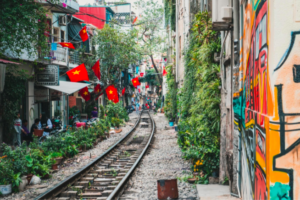Can conservation and tourism co-exist in Coron?
We slip into the glassy, emerald waters of one of Asia’s cleanest lakes, our hands feeling our way past smooth underwater boulders. Crystal clear visibility reveals a moonscape beneath the surface of Coron’s Kayangan Lake. Encircled by soaring, vegetation- clad granite cliffs and with no other tourists around, it’s quiet, even sacred, like the inside of an old cathedral. As we swim further out, we hit alternating pockets of warm and cold water, the result of thermoclines created by a mixing of fresh and saltwater.
“The lake is 70% freshwater, 30% saltwater, and 10% pee during high season,” laughs Joyce, our guide for the day, sporting a fun pixie cut to match her vivacious personality and broad smile.

View from Kayangan Lake
We scamper back up the 170 steps for one of the most beautiful vistas in all the Philippines, looking out over Coron Bay, dotted with leafy karst islands surrounded by electric aquamarine waters. It reminds us a little of Vietnam’s Halong Bay, but with much more to do including diving WWII-era wrecks and hiking more than 700 steps up Mt. Tapyas with its giant white cross and sweeping views.
Located in northern Palawan, Philippines, Coron (meaning “cooking pot” for its surrounding rugged topography) is both the name of the town, confusingly located on Busuanga Island, and the island of Coron, just across the bay. Coron belongs to the Calamian Island group which in turn is part of nearly 1,800 islands that make up the Palawan archipelago, called by Jacques Cousteau as Earth’s “last frontier” for its incredible diversity. While most visitors to Palawan are more familiar with El Nido, having been the paradisiac setting for everything from The Amazing Race to The Bourne Legacy, sleepy Coron is fast becoming a tourist hotspot for its pristine beaches, turquoise waters, limestone cliffs, and some 20 blissfully secluded islands.
The area received even more attention when Travel + Leisure magazine named Palawan the “world’s best island” in 2017, a distinction also awarded to the Philippine island of Boracay five years earlier. However, in a twist of fate, the ensuing influx of travelers and unchecked development led to it being labeled a “cesspool” by the Philippine president who last year took the drastic step of completely closing down Boracay for six months of massive rehabilitation. It re-opened this past October, albeit with a slew of new rules, including a cap on overnight visitors and a ban on raucous parties and single-use plastics.
Compared to Boracay, Palawan receives a million fewer annual visitors, mainly due to lagging facilities. Even still, tiny Coron, barely more than a fishing village itself, already struggles with problematic water and sanitation issues.
“Last March, the government arranged a meeting with the travel industry in Coron and asked if we could take in the extra visitors from Boracay,” remembers Jay Sijera of Calamianes Expeditions Ecotours. “But all of our hotel rooms were already booked out until the next year.” Not that there’s ever been that many hotel rooms to begin with.
Norio and his home
Turtle Net
The town is walkable from end to end in about 15 minutes and because most of the attractions are off-shore, there’s a permanent, uncrowded vibe.
Like most other visitors to Coron, we spend our days exploring the surrounding islands where our greatest pleasures consist of snorkeling the crystalline waters teeming with healthy marine life and gorgeous coral gardens, feasting on grilled fish and fresh coconuts, and trying to come up with names for all the different shades of blues and greens. We swim under a low limestone archway which opens up to a hidden lagoon, take dueling Instagram snaps on deserted Malcapuya Beach, and let the water lap at our toes at the Bulog Island sandbar.
One morning, though, we take a break from island hopping and kayak the quiet coastal mangroves instead. We pass groups of young men, waist deep in the brackish water, some fishing while others collect sand for the many on- going construction projects around the island. Just as my flabby arms begin to give out, more accustomed to powering a keyboard than a kayak, we pull ashore in front of a simple, thatched hut. Sitting outside weaving a crab trap is Norio, one of nearly 2,000 indigenous Tagbanua who call Coron their ancestral home with the authority to manage and preserve the island’s marine and land resources.

On the porch of his stilt house shared with some of his 10 children, Norio tells us a little about his life as a fisherman, getting up when the cocks crow to catch crab and fish which his wife takes to market to trade for goods and other food stuffs. In the evenings, after tending the chickens and three pigs, the family gathers around a small portable television powered by a car battery hooked up to solar panels.
Everywhere we look, life in Coron seems to move at a slow and steady pace, like the imperceptible rising and falling of the tide. In the afternoon heat, a group of kids play a game of pick-up basketball on a makeshift gravel court by the boat dock, backed by a giant, idle Ferris wheel. Even the town dogs, known colloquially as askals (a mashup of asong kalye meaning “dogs of the street”), plop down right in the middle of the road, forcing what little traffic there is to go around them. And don’t even think about trying to upload an InstaStory on what the locals call the “turtle net.”

The Lost Frontier?
But that may all soon change. Driving in the hills around town, a colorful contrast of scrubby vegetation poking through red, manganese-rich soil, we notice shells of buildings going up with signs announcing imminent resort openings. Closer to town, an empty lot overrun by weeds has been marked as the site for a future McDonald’s, Coron’s first international franchise.
The signs are there. Change is coming to Coron. It’s now a matter of making sure the last frontier doesn’t become a lost one. Some, like Vietnamese-Australian David Vo, see the silver lining in the promise of increased tourism. “There are ten times more tourists compared to when I moved here in 2011,” he says, now settled with a local wife and a pizza joint. “There are obvious signs of growth—more cars, homes being converted into shops. More restaurants, even McDonald’s, mean people will have more of a choice. More competition will lead to better services and products.”
Returning from a four-year stint in Manila last year, Jay initially felt sad at all the changes he witnessed in Coron. “There was more construction and the town was busier at night. But then I realized that tourism brought jobs here so people wouldn’t have to leave to find work.”
While more pesos translate to more prosperity, there is concern about how a boom in tourism might forever change life in laid-back Coron. “I never lock my door now,” says Joyce. “There’s no crime here and hardly any motorbike accidents. But more people coming will mean higher prices and more trash. The tour guides get together every month to clean up the ocean and last month we collected 20 sacks of trash,” she says.

Taking heed of warning examples like Boracay, Coron is already instituting sustainable measures against the impact of increased tourism. Paper bags have replaced plastic ones while programs aimed at raising environmental awareness are in place, as are natural conservation regulations. “Ten years ago, even tour guides were throwing plastic into the sea. Now they’re helping to collect it,” says Al Linsangan, Executive Director of the Coron & Calamianes Cultural Conservation Networks Inc. “Coron was once a hotspot for illegal and overfishing. Now we have more than 30 protected areas where no fishing or snorkeling is allowed, the most in the Philippines. Coron can be a model of conservation together with tourism, instead of just one or the other.”
Another of Coron’s environmentally- friendly initiatives are its electric tricycles. One late afternoon, we hop aboard a particularly snazzy one playing a happy Jack Johnson soundtrack bound for Maquinit, one of only a handful of saltwater hot springs in the world. We pass school kids in crisp uniforms and shops selling cashew nuts (one of the few crops to grow in Coron). Suddenly, we veer off the main road and onto a deeply- rutted dirt path leading to the pair of 40oC pools set amidst mangroves by the sea. “The locals call this ‘Abortion Road’,” says Henry, our affable driver. He seems to rethink sharing this bit of trivia and follows quickly with a shy, “I’m sorry, sir.”
Three years ago, Henry moved to Coron from Cebu with his young wife in search of opportunity where life was quiet and crime-free. His days are spent ferrying tourists, sacks of rice, and blocks of ice around town in his electric tuk-tuk, a sustainable but expensive mode of transportation. “The tariffs for gas and electric tricycles are the same,” he laments in confident English learned on YouTube, “but it costs more to charge the batteries than to buy gas.” Once his wife finishes college, he hopes to trade his electric tricycle in for a gas-powered one instead.

Aboard Henry’s tricycle
Perhaps without realizing it, Henry has succinctly summed up the sustainability issue that faces Coron, writ small. While managing resources, being eco-friendly and limiting mass tourism all sound good, it ultimately comes with a price.
That’s why Al favors positioning Coron as a high-end, low-impact destination, suggesting a model like Bhutan where foreign tourists are required to spend at least USD200 per person per night on accommodation, meals, licensed guides and internal transport. “That way visitors can enjoy Nature with lots of space, but they will have to pay.”
He also highlights the importance of local management of resources, like the municipally-owned snorkeling gardens whose entrance fees boost the local economy. “As the landscape changes, it leads to cultural erosion and a loss of local identity,” he warns. “The players now aren’t necessarily local anymore.”
But for Al and many others, it’s a price worth paying. “Other places are beach, beach, beach. Here we have everything: lakes, hot springs, reefs, wrecks, indigenous peoples, the only savannah lands in Palawan. Coron is incredibly special. That means we have a responsibility to protect this place.”

If you go
We enjoyed our stay at the Corto del Mar (www.cortodelmar.com), an easy 5-minute walk to the center of town. The 32 rooms and suites around a central swimming pool gave off a Spanish hacienda vibe with distant sea views. Rooms were spacious and clean while Wi-Fi was available in the lobby. The garlic aioli that accompanied the welcome fries was wonderfully addictive. Doubles start at USD96 including a hearty Western or Filipino breakfast set.
All our tours were organized through Calamianes Expeditions Ecotours (www.calamianes.com). Run by the husband-and-wife team of Al and Mae Linsangan, pioneers of ecotourism in Coron, the company o ers well-organized private as well as join-in tours around Coron. Our group of four found the private tours very reasonably priced, including a morning of kayaking and two days of island hopping. Delicious lunches are prepared using ingredients from the couple’s own farm.
To explore the town of Coron, including the Maquinit Hot Springs or to do a city tour, contact Henry Beltran (cantanciobeltran@yahoo.com). His electric tricycle was new and comfortable and he was just an all-around nice guy to be around.
Images by James Pham and Al Linsangan

